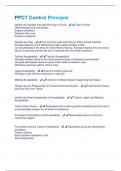Exam (elaborations)
PPCT Control Principle Questions And Answers Latest Updates
- Course
- Institution
Identify the Variable that affect the Use of Force - ️️Type of crime, Officer/subject size and gender, Exigent conditions, Reaction time, and Access to weapons Reactionary Gap - ️️The minimum safe zone that an officer should maintain. Average distance of the Reactionary Gap is approxi...
[Show more]



